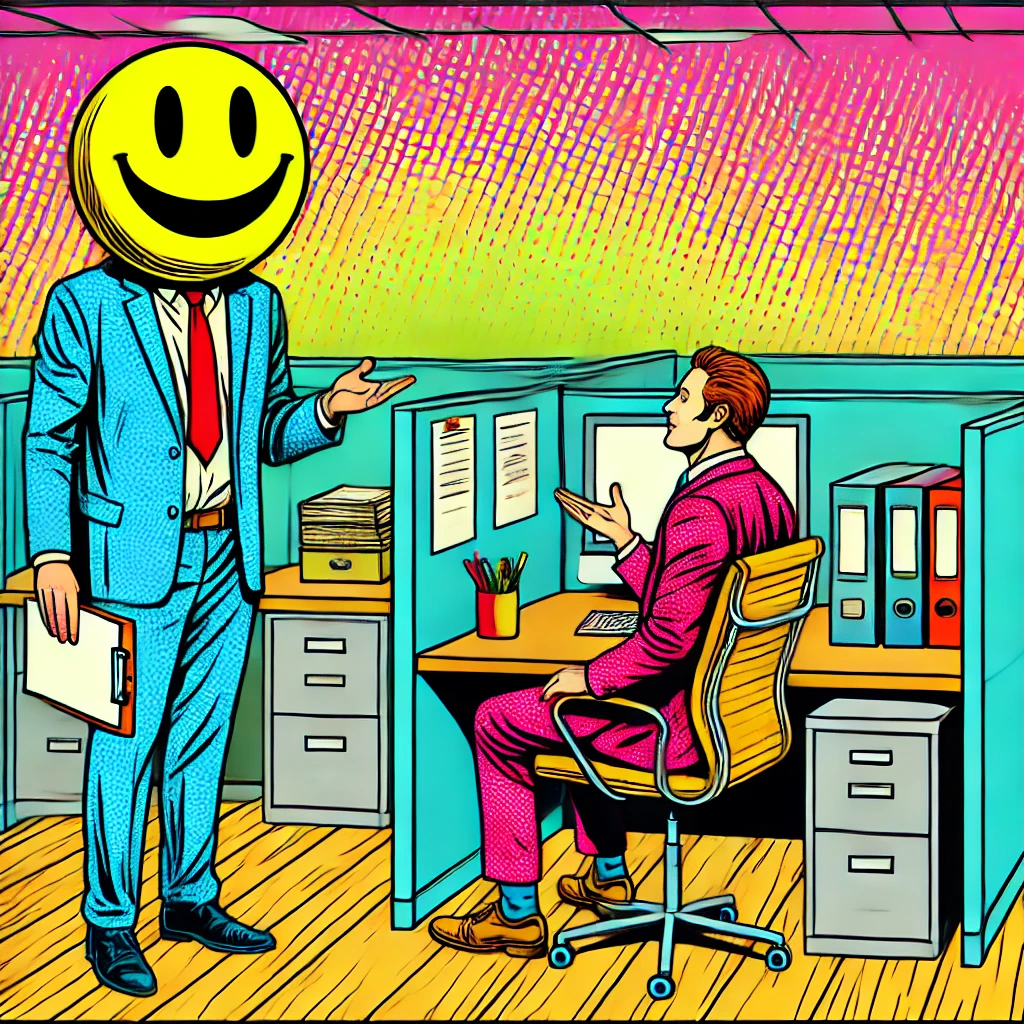There’s a story among small businesses that we watch play out again and again…does it sound familiar to you?
You’ve built a solid team and pride yourself on being a compassionate leader. Your door is always open, and you go the extra mile to accommodate your employees’ needs. But somewhere along the way…things start slipping. Projects come in overtime and overbudget. Employees seem disengaged and aren’t following through with processes the way you’ve taught them. Everyone is taking home a decent paycheck…except you!
Welcome to the Nice-Guy Syndrome club.
Meet Mr. Nice Guy

Nice Guy Syndrome, in the world of business, is when leaders prioritize being overly accommodating, often at the expense of making tough decisions. It’s a path paved with good intentions—valuing your team, being understanding, and creating a harmonious workplace. But when this approach leads to avoiding conflict and letting standards slip, it can become a silent business killer.
A “Nice Guy” leader who avoids holding people accountable can create an environment where expectations are unclear, and mediocrity becomes the norm. This lack of accountability is a breeding ground for disengaged and unproductive employees.
According to a Gallup poll, actively disengaged employees cost U.S. companies over $960 billion annually in lost productivity. That’s not just a hit to the bottom line; it also sends a message to your top performers that mediocrity is tolerated. When high achievers see that underperformance goes unchecked, they become demotivated: according to a study by Leadership IQ, they become more likely to leave for better opportunities, causing a brain drain.
To make matters worse, in an attempt to fix these issues, a “Nice Guy” leader might resort to throwing money at the problem, offering raises or bonuses without tying them to accountability or performance. What does this look like? Wage creep! Employees are now earning more… for doing less. This financial imbalance is a cancer to a business, as it becomes nearly impossible to reverse.
Nice Guy Syndrome can also lead to broader, more systemic issues across the business—diminished morale, lower productivity, and a culture that struggles to foster growth. These impacts ripple through every level of the organization, creating deeper challenges that can be harder to overcome over time.
Examples of Nice Guys
Let’s look at a few examples of Nice\ Guy Syndrome in action from real-world contractors in recent years:
The Role Blob: Alex experienced this firsthand with his admin, Jordan. Over time, Jordan’s role morphed, and her compensation grew disproportionately to her actual contributions. Upon closer inspection, it turned out many of her “responsibilities” were one-off tasks, and much of her work could be outsourced more efficiently. This left Alex’s business overpaying for underperformance…for years! A situation that could have been avoided with clearer expectations and accountability.
The Payroll Predicament: Frank avoided firing an employee who made unauthorized changes to their payroll. Instead of taking decisive action to remove this employee altogether, he tried to find a path that involved keeping this employee in their seat, ultimately resulting in increased costs and undermining the trust of his other employees. Had Frank addressed the issue directly and decisively, the fallout could have been mitigated, and it would have set a tone preventing future abuse by other employees.
The Toxic Manager: Paul had a manager whose behavior was toxic to team morale and even caused safety risks. Paul let their pre-existing personal relationship get in the way of making a tough decision, because he was concerned that setting boundaries or firing this manager would result in making him look bad to their shared church community. The result? This employee neglected wage issues brought up by other teammates (massive liability and issues for the business), and systemically cut corners on processes–resulting in lost clients, and created unsafe workplace scenarios that directly endangered not just the team but clients as well. To add insult to injury, during all of that, this manager continued to bring home a bigger paycheck than Paul!

These real-world examples illustrate how being overly accommodating can lead to long-term consequences that affect morale, productivity, safety, and ultimately, the bottom line.
Identifying the Nice Guy
Now, let’s see if you recognize these symptoms:
- Conflict Dodge: Avoiding tough conversations to keep the peace. By sidestepping issues, leaders unknowingly allow problems to fester, which can ultimately result in bigger confrontations down the line. Facing conflicts head-on with clarity and empathy is crucial for maintaining a healthy team dynamic.
- Service Creep: Adding new services or tasks instead of addressing core issues. Rather than solving the core problems within your team or business model, it’s easy to think that adding new offers (or adding more people!) will solve everything. The reality? It just adds more complexity and dilutes your core strengths, leading to burnout without any real solutions.
- Undervalued Overload: Putting in more time and effort than anyone else, while earning less. This symptom is when you, the leader, end up carrying more weight than your entire team combined—sacrificing your own financial well-being in the process. This isn’t sustainable, and it often signals that others aren’t being held to the standards they should be.
- Invisible Authority: Repeatedly reminding employees about processes, only to have them ignored. This happens when your authority is undermined because there are no consequences. Repeatedly pointing out what needs to be done without follow-through makes your expectations feel optional rather than essential.
- Bonus Band-Aid: Throwing financial perks at underperformance as a quick fix. It doesn’t actually address the root problem, and often ends up rewarding mediocrity. The short-term boost in morale from a bonus can quickly fade, especially if the underlying performance issues are never resolved.
- Mediocrity Magnet: Tolerating underperformance, which demotivates top talent and invites turnover. When underperformers face no repercussions, your top performers notice—and they often decide to leave for a workplace that values their effort. This leads to a vicious cycle of retaining only those willing to coast.
- Role Blob: Allowing job responsibilities to morph without clear expectations or limits. When a leader doesn’t focus roles on clear deliverables or isn’t sure how employees are spending their time, roles become unclear and employees may begin driving their own agendas. Over time, without proper structure, roles can become unrecognizable, leading to confusion and wasted time.
When you start to fix Nice-Guy Syndrome with systems to create visibility and accountability, your employees will often push back. Accountability is very uncomfortable when it hasn’t been there before, and employees may resist new tools or processes designed to make the business healthier. Hold strong, even if it means some of your team are “managed out” as the business becomes healthier.

No more Mr. Nice Guy
So, how do you turn things around? Try this:
- Set Clear Boundaries: Make sure everyone knows what’s expected of them and hold them accountable. Boundaries set and enforced by clear reporting systems eliminate the ambiguity that allows Nice-Guy Syndrome to take hold by making management expectations black and white.
- Prioritize Accountability: Implement systems for accountability, so performance is rewarded fairly. The core of accountability is to create a clear, visible way of seeing what each team member should be doing, when, and what the results should be. Tools like block scheduling and consistently reviewing the metrics around each role are critical for success.
- Regularly Review Compensation and Roles: Ensure alignment between contributions and compensation. Make sure everyone can clearly answer exactly what they do for the business on a daily and weekly basis, and how that drives results for the business goals.
- Practice Proactive Conflict Resolution: Face issues head-on instead of sweeping them under the rug. When you have that gut-feeling that something isn’t quite right, or something shouldn’t be so hard…listen to it. Get rid of the source of that stress–even when it’s a team-member!
- Seek External Support: Don’t hesitate to bring in outside help for an objective view. There is a reason “consultants” have a reputation for shaking up a business–because ultimately, if you can’t make the hard call, you should enlist someone on your side who will help you do it for the sake of righting the ship.
Nice-Guy Syndrome is often rooted in good intentions, but without balancing kindness with effective leadership, a business can quickly falter. By recognizing these symptoms and implementing accountability and boundaries, you can foster a culture of productivity and fairness—one where both the business and its people thrive.
Ready to make some changes? Start with just one of these recommendations, and watch your business transform!
Morgan Knox is a speaker, consultant and business coach. She specializes in technology, AI applications for business, and understanding the future of marketing.


